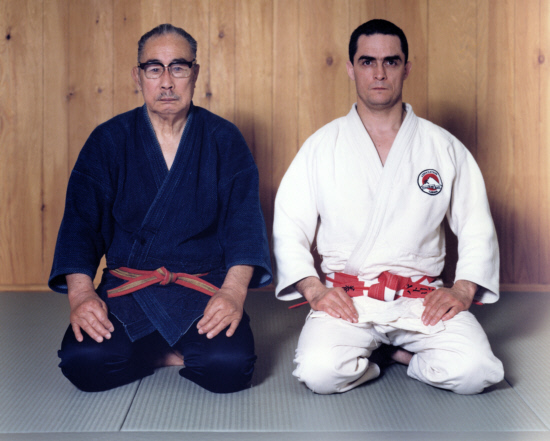the Way of Bu

by Winking Owl
Force is possible
against resistance only.
Water flows around
What really matters? On the day when I buckled down to write about aikido, our dear old tabby cat succumbed to diabetes. We had to take him to the animal hospital, to say goodbye. As we waited for the vet to prepare him, I concentrated on the scene outside the window, cars tearing east and west through the winter cold on the highway, a stone's throw away. It struck me how absorbed everyone is, rushing, taking care of business, oblivious to sorrows lying close at hand. The nurse brought Keoki in, and he was happy to see us, but there was a catheter in his vein. Then sedation and stillness. The final injection. His beautiful eyes clear and bright, unseeing.
Back home again, my wife practiced her violin. I returned to writing. In the evening she went to her Slow Jam and I, thankfully, to my aikido practice.
I started in aikido just after New Year's Day 1981, in Ottawa. I had been looking to improve my physical fitness. A writer in a local newspaper remarked how much she missed enjoying her aikido practice during the holidays, and was glad to be back at it. I had done a bit of judo in university but lost interest when I did poorly in competitions. And to me, going to a gym seems like mind-numbing Work! But I like to play and discover. Aikido could be enjoyable? Let's Go!
My first teachers were Patrick Augé and Kaoru Sugiyama. Now they have their dojo (martial arts school) in Los Angeles. For many years they had studied in Japan under Mochizuki Minoru, O'Sensei ('great teacher'), who was a prominent pre-WWII student of aikido's founder, Ueshiba. Mochizuki had dispatched Augé Sensei to serve as his technical director of Yoseikan Budo in North America.
I learned aikido very slowly but I figured that if I quit I would never find anything as good for me, and I didn't want to be a perennial beginner at everything. Our daughter and son were born in 1987 and 1990, so time got tight, but I didn't want our kids to think Daddy is a wimp. In 1995 I earned my level-one black belt. Who has such patience and perseverance? I did not, but they found their way in.
In 1989 Master Mochizuki came to North America on his Nihon Jujutsu tour. He visited Augé Sensei in his Ottawa dojo. I was a student there, as was my current teacher, Lau Hiang-Lai, and quite a few others who are still practicing in the area. I anxiously shot the portrait that you see here. 
The road forked. Martial arts promote harmony, but organizations splinter. It can be tricky to trace bona fide Yoseikan Budo, now that O'Sensei is gone. Still his principal dictum of Mutual Welfare and Prosperity remains the touchstone at our Jiseikan dojo, as elsewhere.
In the realm of Japanese martial arts, Mochizuki O'Sensei is a legend. Nevertheless as Augé Sensei told us, he was a gentle and humble man who lived simply and attentively: After a meal on a flight he would carefully gather his utensils and containers and wrappings together neatly on his tray to minimize the work of the attendant who would clear them.
O'Sensei cautioned his students to not let strong likes and dislikes dictate their lives. Once Augé Sensei asserted that he himself didn't need many of the comforts that others do. I said to him Yes Sensei, but you need the comfort of knowing that you don't need those other comforts. He laughed. Often it isn't strong desires that are a problem, but ones not strong enough. It depends on what purpose they serve.
Aikido is one aspect of Budo (the Way of Bu). The Japanese character Bu, 武, has three parts: One part is Yamé, 止, which means Stop (We use that word in the dojo to indicate the end of an exercise). The other parts together mean Conflict. So Budo is the Way of Stopping Conflict. Aikido intrigues us into awareness of principles that apply to life in general.
The dojo is a laboratory of human interaction, a place to experience and respond, to safely and sincerely play out conflict and resolution, to engage our partners in wordless conversations that are intense and revealing. We don't compete. We cooperate. Our first concern is to protect our partners from harm. The purpose of our grading examinations is to show us our own natures and behaviors.
A friend recently asked me how I think aikido has benefitted me. I replied that it has brought me physical and mental fitness for my career and personal life. He said sure but he could see something more immediate and tangible: it gives me a community, and within that, status and responsibility. He was referring to my rank of black belt and my role as resident photographer. He was right.
Photography for our dojo stretches my imaging skills. To fittingly commemorate our events, I explore different types of collages and dynamic tableaus. Sensei encourages that. I've come a long way from lining people up by rank and height.
In the dojo, our educative activities help me to grow as an empathetic element of ethical society. It is a network of cooperation and respect and trust among diverse people. I am older than my teacher, and older than nearly all of my partners. They help keep me young. Training impels me to deal with any bodily deteriorations immediately, so I won't become irreversibly a couch potato.
Teacher/student relationships determine the character of a dojo. In 2007 Augé Sensei had recommended that his students read The Life of Mila Repa. Afterwards I wrote to him:
What is on my mind is the idea that Mila's teacher Marpa knew what was good for him, better than Mila himself did. What Mila knew was this - that Marpa could guide him, so Mila was able to put himself in Marpa's hands. People in cults do that kind of thing, thinking they are safe and cared for.
He replied:
Marpa was a fair teacher who treated everyone of his students according to their needs, not according to their wishes. Mochizuki Sensei was also that kind of teacher, that's why so many people misunderstood him since he was treating everyone differently.
In order to accept to be under such a teacher one must first understand the meaning of a teacher-student relationship. Without that kind of trust, one cannot build such a relationship. That's why so few people here are able to stay with the same teacher. In Europe and in Asia, that kind of value tends to be taught at an early age.
Talking of cults, the question to ask oneself before trusting a teacher is: "Is he doing this for himself, for his own convenience, or is he truly doing it for us?"'
Does my teacher have my best interests at heart? Does he care about me as he cares about each of his multitudes of bonsais that he feeds and waters and trims, year after year, and brings into the dojo in winter for warmth? Was I invigorated, accompanying him on training pilgrimages to the cradle of Tai Chi and Kung Fu? Do I thrive? Flourish?
Yes.
I slept and I dreamed that
life is all joy.
I woke and I saw that
life is all service.
I served and I saw that
service is joy.